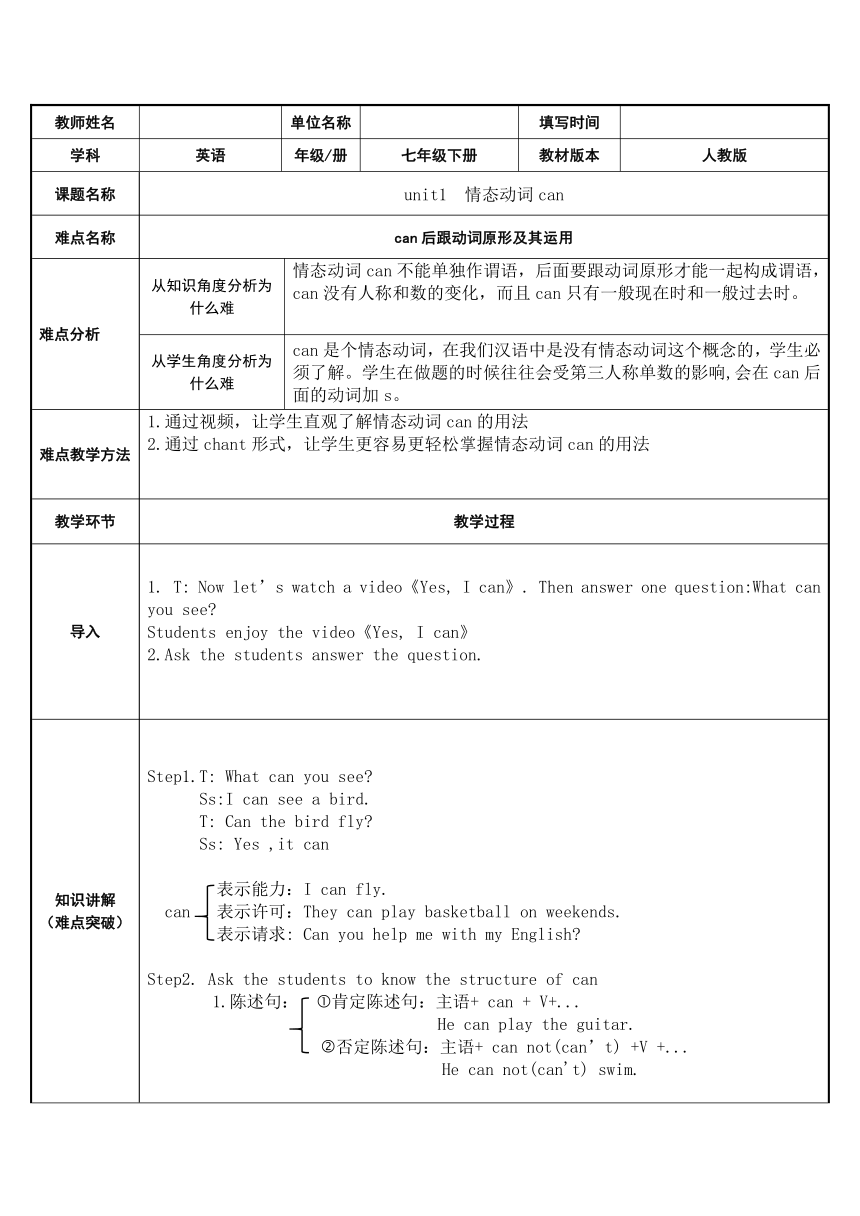unit 1 Can you play the guitar?情态动词can (表格式教案)
文档属性
| 名称 | unit 1 Can you play the guitar?情态动词can (表格式教案) |

|
|
| 格式 | doc | ||
| 文件大小 | 39.0KB | ||
| 资源类型 | 教案 | ||
| 版本资源 | 人教新目标(Go for it)版 | ||
| 科目 | 英语 | ||
| 更新时间 | 2022-03-08 09:12:39 | ||
图片预览

文档简介
教师姓名 单位名称 填写时间
学科 英语 年级/册 七年级下册 教材版本 人教版
课题名称 unit1 情态动词can
难点名称 can后跟动词原形及其运用
难点分析 从知识角度分析为什么难 情态动词can不能单独作谓语,后面要跟动词原形才能一起构成谓语,can没有人称和数的变化,而且can只有一般现在时和一般过去时。
从学生角度分析为什么难 can是个情态动词,在我们汉语中是没有情态动词这个概念的,学生必须了解。学生在做题的时候往往会受第三人称单数的影响,会在can后面的动词加s。
难点教学方法 1.通过视频,让学生直观了解情态动词can的用法2.通过chant形式,让学生更容易更轻松掌握情态动词can的用法
教学环节 教学过程
导入 T: Now let’s watch a video《Yes, I can》. Then answer one question:What can you see Students enjoy the video《Yes, I can》2.Ask the students answer the question.
知识讲解(难点突破) Step1.T: What can you see Ss:I can see a bird. T: Can the bird fly Ss: Yes ,it can 表示能力:I can fly. can 表示许可:They can play basketball on weekends. 表示请求: Can you help me with my English Step2. Ask the students to know the structure of can1.陈述句: 肯定陈述句:主语+ can + V+... He can play the guitar.否定陈述句:主语+ can not(can’t) +V +... He can not(can't) swim.2.一般疑问句: Can + 主语 + V… 肯定回答: Yes,主+can. 否定回答:No,主+can't.Can she sing Yes,she can. No, she can't.3.特殊疑问句: 疑问词+ can +主语+ V… What can he do Step3.Let's chant. 情态动词,can,can,can,后面紧跟动词原形,否定句,后加not,疑问句,can句首站,不管主语是何人,情态动词can都不变。Step4.Do some excercisesStep5.Summary T:What have we learned today Ask the students conclude.
一、单项选择1.--Jack, can you ride a bike --Yes, I ___.A.can B.may C.need D.must2.--____you speak Japanese --No,I can’t.A.Should B.Can C.May D.Must3.Her sister can _____ English songs. A.sings B.to sing C.sang D.sing二、句型转换1.She can play the piano.(改为否定句)—————————————————2.Mary can play pingpong.(改为一般疑问句并做肯定和否定回答)—————————————————3.David can do Chinese kung fu.(对画线部分提问)—————————————————
小结 情态动词can表示“能,会,可以”;没有人称和数的变化;后面紧跟动词原形;变为否定句,直接在can后加not(can not=can’t);变为一般疑问句,把can提到句首;时态只用一般现在时can和一般过去时could。
学科 英语 年级/册 七年级下册 教材版本 人教版
课题名称 unit1 情态动词can
难点名称 can后跟动词原形及其运用
难点分析 从知识角度分析为什么难 情态动词can不能单独作谓语,后面要跟动词原形才能一起构成谓语,can没有人称和数的变化,而且can只有一般现在时和一般过去时。
从学生角度分析为什么难 can是个情态动词,在我们汉语中是没有情态动词这个概念的,学生必须了解。学生在做题的时候往往会受第三人称单数的影响,会在can后面的动词加s。
难点教学方法 1.通过视频,让学生直观了解情态动词can的用法2.通过chant形式,让学生更容易更轻松掌握情态动词can的用法
教学环节 教学过程
导入 T: Now let’s watch a video《Yes, I can》. Then answer one question:What can you see Students enjoy the video《Yes, I can》2.Ask the students answer the question.
知识讲解(难点突破) Step1.T: What can you see Ss:I can see a bird. T: Can the bird fly Ss: Yes ,it can 表示能力:I can fly. can 表示许可:They can play basketball on weekends. 表示请求: Can you help me with my English Step2. Ask the students to know the structure of can1.陈述句: 肯定陈述句:主语+ can + V+... He can play the guitar.否定陈述句:主语+ can not(can’t) +V +... He can not(can't) swim.2.一般疑问句: Can + 主语 + V… 肯定回答: Yes,主+can. 否定回答:No,主+can't.Can she sing Yes,she can. No, she can't.3.特殊疑问句: 疑问词+ can +主语+ V… What can he do Step3.Let's chant. 情态动词,can,can,can,后面紧跟动词原形,否定句,后加not,疑问句,can句首站,不管主语是何人,情态动词can都不变。Step4.Do some excercisesStep5.Summary T:What have we learned today Ask the students conclude.
一、单项选择1.--Jack, can you ride a bike --Yes, I ___.A.can B.may C.need D.must2.--____you speak Japanese --No,I can’t.A.Should B.Can C.May D.Must3.Her sister can _____ English songs. A.sings B.to sing C.sang D.sing二、句型转换1.She can play the piano.(改为否定句)—————————————————2.Mary can play pingpong.(改为一般疑问句并做肯定和否定回答)—————————————————3.David can do Chinese kung fu.(对画线部分提问)—————————————————
小结 情态动词can表示“能,会,可以”;没有人称和数的变化;后面紧跟动词原形;变为否定句,直接在can后加not(can not=can’t);变为一般疑问句,把can提到句首;时态只用一般现在时can和一般过去时could。
同课章节目录
- Unit 1 Can you play the guitar?
- Section A
- Section B
- Unit 2 What time do you go to school?
- Section A
- Section B
- Unit 3 How do you get to school?
- Section A
- Section B
- Unit 4 Don't eat in class.
- Section A
- Section B
- Unit 5 Why do you like pandas?
- Section A
- Section B
- Unit 6 I'm watching TV.
- Section A
- Section B
- Review of Units 1-6
- Unit 7 It's raining!
- Section A
- Section B
- Unit 8 Is there a post office near here?
- Section A
- Section B
- Unit 9 What does he look like?
- Section A
- Section B
- Unit 10 I'd like some noodles.
- Section A
- Section B
- Unit 11 How was your school trip?
- Section A
- Section B
- Unit 12 What did you do last weekend?
- Section A
- Section B
